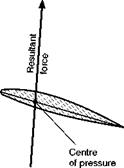Total resultant force on an aerofoil
If we add up the distributed forces due to pressure over an aerofoil, and replace it by the total resultant force acting at the centre of pressure, we find that this force is not at right angles to the chord line nor at right angles to the flight direction. Near the tips of swept wings it can sometimes be inclined forward relative to the latter line due to rather complicated three dimensional effects, but over most of the wing, and on average, it must always be inclined backwards, otherwise we would have a forwards component, or negative drag, and hence perpetual motion.
Although the force must on average be inclined backwards relative to the flight direction as in Fig. 3.10 it can often be inclined forwards relative to the chord line normal. Figure 3.10 illustrates the situation. You will see from this figure that there can be a component of the force that is trying to bend the

 |
Direction of airflow
Fig 3.10 Inclination of resultant force
wings forward. This may come as a surprise, because you might have expected that the wings would always be bent rearwards.











